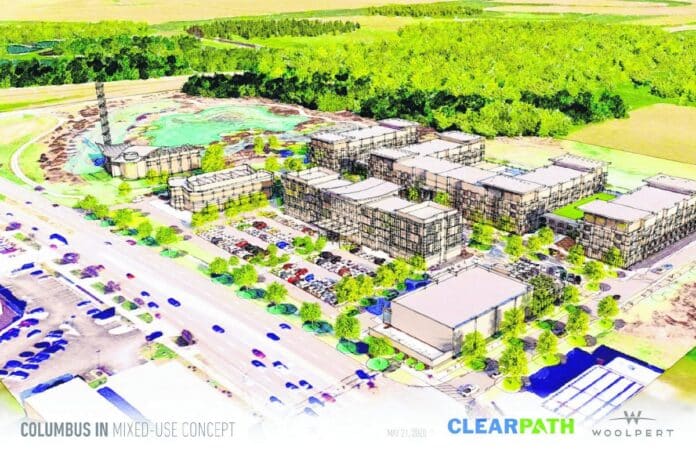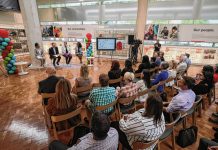
Columbus Regional Health, working with partners, will turn the former Clarion hotel site on Columbus’ west side into a mixed-use development with construction expected to begin later this year.
The announcement on Wednesday came nearly four years after CRH purchased the site through a holding company in July 2017, with the acreage, which has been prone to flooding due to its proximity to a wetland, becoming a fill site with road construction debris since then.
CRH has signed an agreement with Clearpath Services of Bloomington, to sell the site while still retaining a parcel of land within the mixed-use development for hospital programs and services.
“After an exhaustive and thorough process to make sure the property was environmentally and economically viable for the planned development, and further delays brought on by the COVID-19 pandemic, we are excited to relaunch efforts surrounding this site,” said CRH President and CEO Jim Bickel in an official statement.
Clearpath, in partnership with architecture, engineering and geospatial firm Woolpert, will work with CRH on the design and construction of a medical building, while integrating it within the larger plan for the site, which is located on State Road 46 and the I-65 interchange considered a gateway area to the city from the west side.
The project is anticipated to include over 550,000 square feet of mixed-use space. The property itself is just over 20 acres.
In addition to a CRH facility, potential components of the site could include a hotel, a small grocer, retail spaces, dining, multifamily development, an interpretive center, amenities related to nearby wetland features and a spur trail off of the People Trails, said Woolpert Senior Associate and Director of Design Tony Martin.
Randy Lloyd, principal and general counsel at Clearpath, said that the development could encompass over $90 million “in investment on the project side.”
Clearpath expects to begin the formal approval process through the city this summer. If approval is granted, construction would likely begin in the fourth quarter of 2021.
The hospital system will likely wait until closing the deal on the property to announce the final amount for that sale, Bickel said. CRH will retain ownership of its acreage and facility.
CRH officials have said in the past that proceeds of a property sale would be used to finance construction of a new healthcare facility on the remaining land.
More partners for the project’s different uses will be announced at a later date, Lloyd said.
The current project partners said they have already spoken with the city and some community partners and also plan to engage the public and to obtain input about the project.
For their space at the site, CRH plans to design and construct an approximately 36,000-square-foot facility. This facility will house both new and existing services with a focus on diagnostic and procedural outpatient services, along with other medical office building services, including physician office space.
The hospital system intends for the mixed-use site to “address short-term health system needs for existing services and provide room for growth and service expansion.” Bickel said that it will also help increase CRH’s west-side presence.
“It will also provide economic development opportunities for the community and surrounding region,” CRH officials said.
As part of their announcement, the project partners shared a site plan and rendering of their vision for the property. The plan may change over time, depending on what comes up during the due diligence phase and the economics of the project, Lloyd said.
One of the pieces envisioned for the site is an interpretive center and monument that would pay homage to the architectural history of Columbus, Martin said.
This could provide an opportunity to partner with high-profile designers as well as Indiana University’s Master of Architecture program in downtown Columbus.
The monument’s current depiction on the site plan is “notional” and functions as a placeholder, rather than a set-in-stone design, Martin said.
The site plans paint a very different picture than the property’s present state. The former hotel site is covered with heaps of rubble and has been described as an “eyesore” and “a dump” by some local residents who have asked for it to be redeveloped for years.
This pile contains both rubble from the former building and debris from the Indiana Department of Transportation’s I-65 expansion project. CRH plans to use this material to raise the property above flood grade level.
The rubble hasn’t been moved yet because CRH needed an infrastructure and site plan so that they could know where to spread it out and what other soils and materials would need to be mixed in with it, Bickel said.
Using existing rubble will help offset costs of additional material and keeps the debris from going to waste, he said..
Woolpert and Clearpath will look at how to use the fill and properly elevate the site, Lloyd said.
The immediate next steps for the project encompass details related to the site, the city’s approval process and the property sale.
While the purchase agreement between Clearpath and CRH has been signed, there is still some “due diligence” for both sides to complete, Bickel said, similar to closing the deal on a house. This will include finalizing the details and size of the parcel that CRH will retain.
Ideally, the partners would like to complete the due diligence phase and close within 120 days, he said.
The property presents a “unique opportunity” due to the number of acres that are available near the interstate, Lloyd said.
Some of his inspiration and vision for this project came from “The Yard,” an urban development in Fishers, north of Indianapolis.
The Yard is a $110 million “restaurant-anchored mixed-use development of dining, entertainment, a unique culinary incubator for start-up chefs and green space for concerts and events.” The Yard also includes residential and hotel space.
“It was a project that I thought was blending sort of this need for attracting people off the interstate but also serving the residents who lived around there,” Lloyd said.
He added that he wanted to create something “unique to Columbus” that at the same time captured the spirit of a “new, urbanus village concept right off the interstate.”
The project is aimed at not only being a gateway into Columbus and attracting people to the development, but also serving to point people downtown and into the larger city, said Lloyd.
“I commend Jim and the CRH leadership and Dave for having the patience to pick something that is, yes, more challenging,” he said, “but certainly something that is unique to Columbus and unique to southern Indiana, for that matter — that is something out of the ordinary in a way that I think makes a statement about how Jim and Columbus Regional use their commitment to this community. And I think Columbus has a high bar, and we want to be at that bar or over it.”




